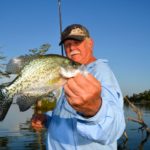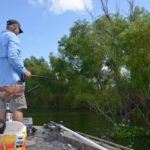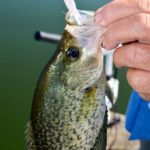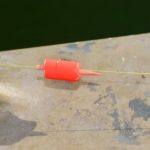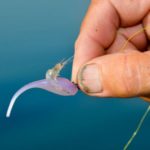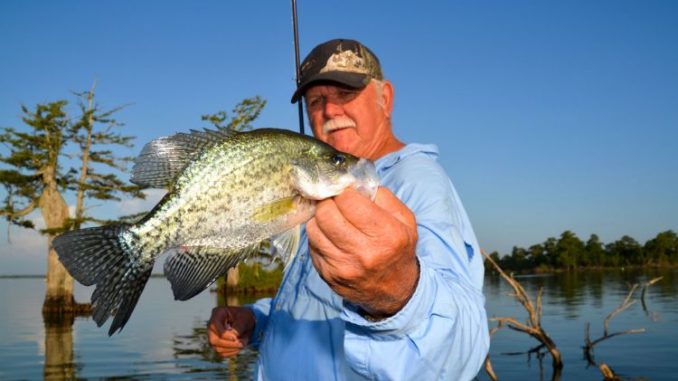
Cajun ingenuity and know-how tempts fickle summertime sac-a-lait
The tiny cork bobbled ever so slightly.
“Bream,” I asked?
“No. It’s a sac-a-lait,” said the man on the bow. “They are just being finicky.”
At least we were catching fish. In the oppressive heat of the summer, that’s better than we could do elsewhere, especially in the shallow marshes and swamps of south Louisiana.
We were in Lake Des Allemands, or more properly “Lac des Allemands,” the 12,000-acre lake located mostly in St. John the Baptist Parish, where it abuts Lafourche and St. Charles parishes.
“Des Allemands” interprets from French literally as “the Germans,” and was named so by the French because of the colony of German immigrants settled in Louisiana in 1721 for the French Crown by the Scottish “entrepreneur” John Law.
Tommy Tregle was doing what he does a lot nowadays, chasing crappie, invariably called “sac-a-lait” in south Louisiana.
I got a good look at the man in the soft morning’s light on the lake: remarkably fit for his age, of medium height and build, with a ruddy complexion, a full silver moustache, and a face well-etched with character lines.
When he spoke, it was with a clipped and fast-talking Cajun accent as thick as sludge, yet melodic at the same time.
“You have to learn this lake by trying — put your time in. When I first started 5 years ago, the other guys were catching 30 or 40. I was catching two.
“You try spots, always near standing cypress trees or tree tops in the water. You remember spots where you caught fish and you go back.
“There are a lot of fishermen out here too. If you are passing and you see someone pick up a fish, you know there are fish there.
“When fishing, hit the trees that you know from experience are best. For some reason, some trees are better than others. Why, I don’t know.
“If they don’t have any fish on them, it doesn’t pay to fish the others nearby. Move to another part of the lake to try. But, if you catch fish at the best trees, fish the others near it.”
“I fish sac-a-lait a lot,” he said in a confessional tone. That’s one advantage to living across the road from my boat house. Almost every night, Debra (his wife) asks me if I’m going fishing tomorrow. If I say ‘no,’ she says ‘why not?’”
I asked how many days a year he fishes. “Oh, I don’t know,” he muttered. I ventured a guess of 100 days a year. His reply was a guilty laugh.
Tregle uses 10-foot crappie poles, noting that he didn’t think the brand was important. “But, I don’t like them too limber; big crappie get off too easily.” And he likes a light pole, noting that fishing all day with a heavy pole makes him tired.
Mounted on his poles are either single action or automatic fly reels, with single action reels being his favorite. The reels are used exclusively for line storage, not fish-fighting.
The reels are spooled with Golden Stren monofilament. He doesn’t use the high-visibility line because he is a tightlining line-watcher. He uses a cork. But he has good reason.
“I can’t see that clear line to tie a knot,” he laughed.
Tregle uses 1/32-ounce jigheads most of the time. “Use the lightest you can get away with. The drop is slower when jigging and a lot of the time, they hit it on the drop.”
He will use 1/16-ounce jigs when fishing at the old Highway 90 bridge in the heart of the town of Des Allemands. There, he is fishing 10 feet deep.
Like many experts at their craft, he doesn’t use a wide variety of lures, instead focusing on finding the fish. His choice of plastics to use on the jigheads is one of three: Bobby Garland albino Baby Shad, Southern Pro Tackle albino Stinger Shad, or Chartreuse and black Lit’l Hustler Crappie Tubes.
He uses small foam “toothpick corks” that he whittles down even smaller, so that they will barely float. “Lots of times,” he explained, “when a fish takes the bait and he feels resistance, he will let it go.
“Sac-a-lait are finicky fish. Some days you know they are there and they just play with the bait. You’ll catch one every now and then. Other days, they don’t hesitate.”
As a final touch, he sweetens the jig hook with a tiny live grass shrimp. “In the middle of the summer, it definitely helps,” he said firmly. “But it’s really kind of a pain.” He has to catch them and keep them alive.
He catches the shrimp with a very fine-meshed dip net that he hand-knitted himself. Before daylight, he scrapes the net along the pilings under the old highway and railroad bridges in Des Allemands. Once caught, he holds them in a plastic bait bucket with a battery operated bubble-up aerator.
Lake Des Allemands is shaped like a 3-leaf clover with three major points extending into the lake. On the east side, where Bayou Des Allemands opens into the lake is Pointe Cypres, so named for its stand of cypress trees. On the extreme western shore is Pointe Abb, what is named Pointe Aux Herbes on most maps.
On the north shore, what is locally called Pointe Cypres Fausse, projects deeply into the lake. Tregle fished all three points and many places in between as well as the willow-lined eastern shore of Two Oaks Bay, what is essentially the greatly widened mouth of Bayou Des Allemands.
It wasn’t hard to see that Tregle placed a distinct emphasis on fishing solitary cypress trees set away from the bank and off of points. Tregle pinned his cork to float his jig about a foot from the bottom in the 4 to 5 feet of water in which he was fishing.
Water color was important to him too. “Look for root beer-colored water,” he coached. “The water is coming from the surrounding marsh and canals. When it first comes out, it’s black and bad.
“But after mixing with lake water it turns root beer-colored.
“Look for the best water, but a lot of times you don’t have a choice,” he shrugged.
Tregle fished standing erect on his boat’s bow deck, operating the trolling motor with one hand and working the rod with the other. “Working” is a subjective term.
He wielded the rod with the grace of a conductor’s wand and the delicacy of a surgeon’s scalpel. No big plops into the water or slashing jerks of his cork. Sometimes he barely moved it at all, seeming to will or tease the fish into taking his offering.
He fished in or near woody cover, but wasn’t the least bit perturbed by hanging up. He didn’t break off either. With his free hand, he pulled the slack out of the line and submerged the rod tip until it touched the hung jig. A simple jig-a-wiggle and it was off.
By midday, Tregle decided that he had punished the sac-a-lait enough. As he put his rod away, he turned to me with a twinkle in his eye, obviously sharing a top-secret.
“I can tell you one thing. It’s always better on the north side of a tree. It’s always on the north side that you will catch them—90 percent!”
When and where
Right after hunting season, sometime in January, Tommy Tregle begins looking for sac-a-lait in the black water of the canals surrounding the lake. While the water is black, usually a sign of low oxygen, at this time of year the water is productive because it is cold and holds oxygen.
Not just canals connecting directly to the lake are good, but also those connecting to bayous surrounding the lake may be productive. Fishing in canals is good into late April.
With warmer weather, the water in the canals becomes deoxygenated and the fish move into Lake Des Allemands proper. At first, good fishing occurs near the shoreline, in waters 2 feet deep or less.
As the weather and water heats up, the fish move deeper, into waters 4 to 5 feet deep. They will remain in the lake until the onset of cold weather, when they move back into the canals.
Some time every summer during the height of the season, a blue-green algae bloom hits the lake. Caused by an over-abundance of dissolved plant nutrients, it looks almost like green paint poured on top of the water.
This creates the odd spectacle of bright green rooster tails arching behind running boats. Typically, the blooms do not cover the entire lake, but rather occur in moving spots. Sac-a-lait fishing beneath algae blooms is not productive.
Blue-green algae blooms occur until the lake’s waters begin to cool in late September.
Tip of the day
Tommy Tregle’s self-designed, self-built boat is wonder of efficiency. Custom-built of welded aluminum, it is 18 feet long with a 12-inch V in the bottom. It looks like a hybrid between a mud boat and a bass boat with a center console.
But the dangest thing is his version of a Cajun anchor. A trolling motor mount on his bow has a 12-foot length of 1-inch PVC pipe in the bracket instead of the motor. (He has his trolling motor mounted on the opposite side of the bow.)
To give the relatively limber PVC pipe some backbone, Tregle has inserted a snuggly-fitted, solid wooden core. “Without the PVC, a bare wooden pole will break,” he said. “With the wood in the PVC, it will bend until you think it will break, but it won’t.”
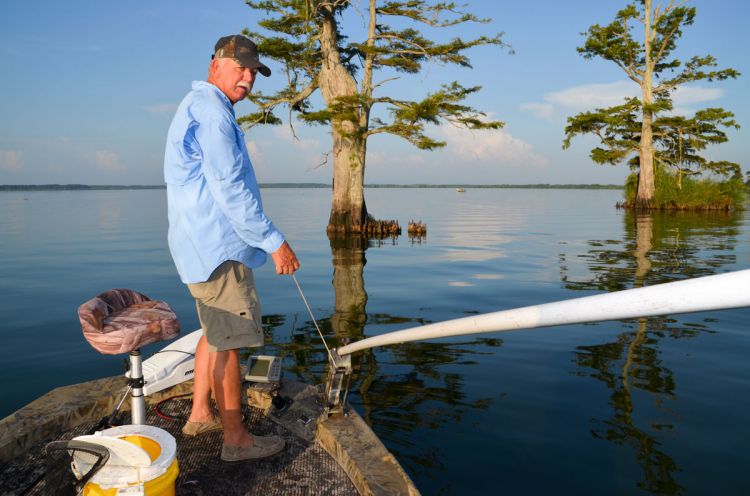 Tregle started the wooden insert by finding a 12-foot length of fir with no knots. With a table saw, he ripped a square length of it slightly larger than the inside diameter of the PVC pipe.
Tregle started the wooden insert by finding a 12-foot length of fir with no knots. With a table saw, he ripped a square length of it slightly larger than the inside diameter of the PVC pipe.
He rounded the square wood to fit the pipe with a planer. He planed it just enough to fit in the pipe. As he shoved the wooden insert in, he planed the wood wherever it stuck in the pipe.
When he got near the end, rather than planning to wood down enough to fit, he heated the PVC pipe with a torch to make it expand, then jammed the wooden insert into it. When the PVC contracted as it cooled, it firmly gripped the insert. He then planed the exposed end of the insert to a point to allow it to more easily penetrate the lake’s bottom.
The pipe is clamped loosely enough in the trolling motor bracket to allow the pipe to be raised and lowered by hand. When he is ready to travel he pulls the pipe up until the expanded end at the bottom is snug in the bracket, then picks up the bracket just like he does with the one holding his trolling motor.
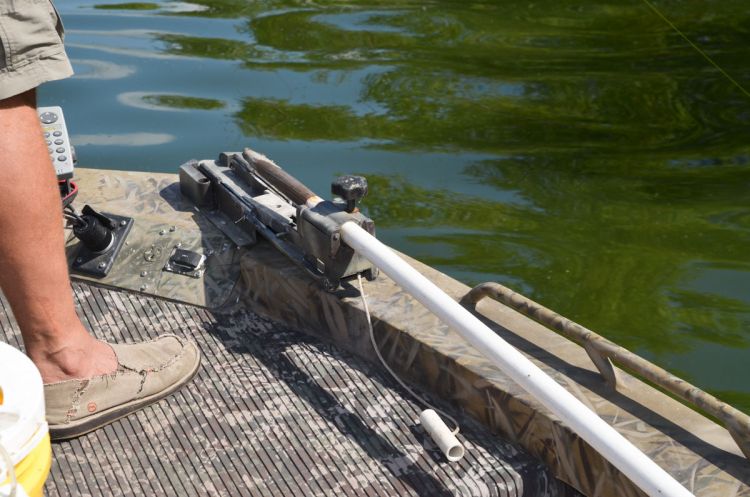
He didn’t seem impressed by my enthusiasm over his invention, but explained its value. “If you get on a good spot, it’s hard to hold the boat right with a trolling motor. You might catch 10 in a good spot with the anchor. Without it, you might catch one.”
A swamp life
Born and raised in the town of Des Allemands, Tommy Tregle (pronounced Cajun style as “Treg”) has spent almost his entire life making his living from the water.
He began commercial fishing in the ninth grade, mostly catfish at first. A one-year stint working at Avondale shipyards after he got out of school taught him that he didn’t want a “regular job.” So he kept fishing.
In 1970, when he was 19, Uncle Sam came calling with a draft notice. When he returned home, he married Debra Percle, whose family came from Chackbay, and went back to commercial fishing, the only life he knew.
It was, of course, for catfish. Des Allemands had been declared the “Catfish Capital of the Universe” by the Louisiana Legislature. But prices were poor. Wild catfish were difficult to sell in the face of competition from farm-raised catfish.
Prices have remained low, according to Tregle. He cited current prices of 45 to 50 cents per pound, the same prices as were paid right out of high school.
So he gradually shifted more and more effort to crab fishing. Of course, crab prices weren’t so hot either. “They were 8 to 10 cents a pound when we started,” he chuckled.
“One year we got 12 cents. We thought that we were rich. That was the first year Debra and I took a vacation. Last year (2015), number one male crabs got up to $5 a pound.”
Tregle didn’t just crab. He fished monofilament gill nets for shad and mullet in Lake Des Allemands under a special bait permit.
“It was great in crawfish season,” he laughed. I couldn’t catch enough. Then after the season, the shad in the freezers just sat there getting freezer burned. Crabbers don’t like shad for bait like crawfishermen do.”
Mixed in this somewhere, while he was still commercial fishing full time, he built wooden catfish slat traps for sale.
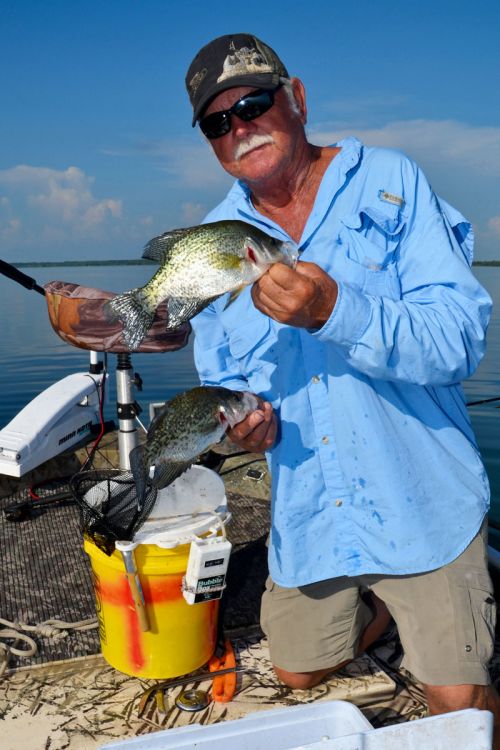 For years, every September, he spent every free moment fishing for alligators with his good friend Dennis Badeaux of Bayou Gauche. “We used to love it, but it got old. The landowner demanded that we skin them, scrape them, and salt them. We couldn’t sell them in the round (uncleaned) like lots of other fishermen.”
For years, every September, he spent every free moment fishing for alligators with his good friend Dennis Badeaux of Bayou Gauche. “We used to love it, but it got old. The landowner demanded that we skin them, scrape them, and salt them. We couldn’t sell them in the round (uncleaned) like lots of other fishermen.”
Always good with his hands, he built wooden boats in his time off from fishing. In the mid-1970s, he and his brother Jerry decided they wanted aluminum boats, the new thing in the fishing industry. But he didn’t know how to weld aluminum.
No problem.
He watched his brother-in-law Bobby Bergeron weld. With a little experimentation and no further instruction, he built their boats. Then he built more. It seemed that everybody wanted a custom-welded boat.
He built them by the hundreds, sometimes two a week. He used his boat-building earnings to build the modern brick home that he and Debra live in now. “We never had a note on that house,” he exclaimed, almost as if surprised how it happened.
With all of this, he still found time for his hobbies, duck hunting, then later deer hunting and most fascinating of all, collecting sinker cypress logs. He explained.
“Years ago, they had a sawmill in Des Allemands that cut cypress into railroad ties. The logs would be floated to the mill in big rafts. Sometimes they broke loose in the lake, waterlogged, and sank.
“We used to find them while we were trammel netting in the lake for big (20- to 60-pound) blue catfish. We would circle them with the net. If we found them in the same place several times, it meant that there is something there to hold them, like a big log.
“My dad Sidney and I used to raise them from the bottom with logging tongs. My biggest one was 6 feet in diameter.”
The pair built everything from the valuable cypress heartwood: pirogues, paddles, and furniture. Things made of cypress were Sidney’s Christmas gifts to others.
Tommy’s biggest project began in 1991, when he gave up fishing and with his wife, opened a crab factory (a south Louisiana term for a crabmeat picking plant) on the bayou bank across the road from his home.
In keeping with form, he built the state-of-the-art 5,400 square foot facility himself. He and his father even drove the pilings. Because of his aluminum welding skills, he built as much of it of aluminum as possible.
“The Board of Health loved the building,” he smiled. “It had aluminum in places where other factories had wood, like door framing”
Their factory employed 20 to 30 people and at its peak, it used 8,000 to 10,000 pounds of crabs per day. He operated the business until 2011, but by then they were only doing 3,000 pounds a day.
“Production began to drop because older Vietnamese women (whose nimble fingers picked the crabmeat from the shells) began to retire and younger ones didn’t want to do that,” he explained.
“Another factor was the advent of grading. In the early days, all the catch went to the factory (straight run). With grading, 4 grades of crabs were sold: #1 males, #2 males, females, and factory.
“What the factories get to pick now can’t be shipped — junk! Factory crabs can’t produce big lumps and the yield is less.
Tommy Tregle is fully retired now.
“This is what I do,” he said as he dropped a jig next to a cypress tree.
“Funny! When I was fishing for a living, I couldn’t stand sac-a-lait. You couldn’t sell them. When you are catching fish to sell, you don’t want to catch a fish you can’t sell.”
He admits to missing commercial fishing at times, but quickly added that he doesn’t miss having to get up early every morning.
